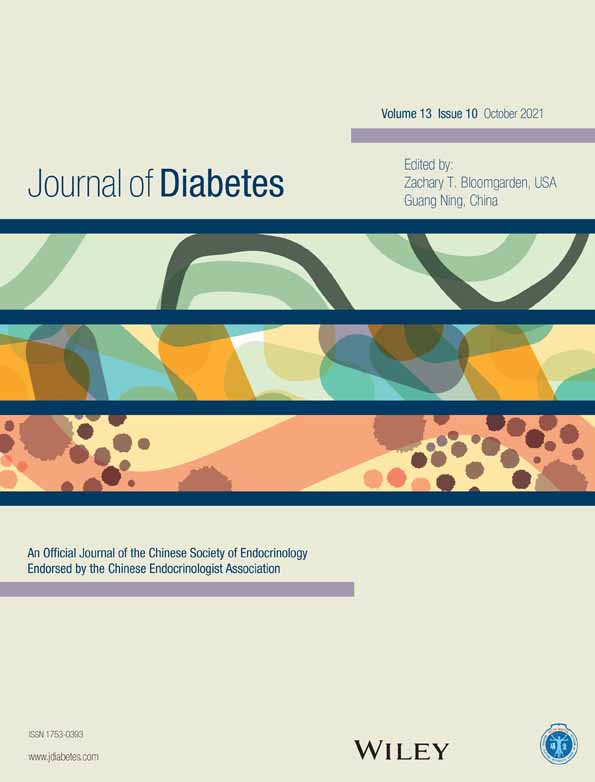Low-dose colchicine in type 2 diabetes with microalbuminuria: A double-blind randomized clinical trial
低剂量秋水仙碱对2型糖尿病合并微量白蛋白尿的作用:一项随机双盲临床试验
Yue Wang, Xiaoqiong Peng and Jinbo Hu are co-first authors.
Funding information: Bethune Merck diabetes research foundation, Grant/Award Number: G2018030; Chongqing Outstanding Youth Funds, Grant/Award Number: cstc2019jcyjjq0006; National key research & development plan, major project of precision medicine research, Grant/Award Numbers: 2017YFC0909600, sub-project: 2017YFC0909602, 2017; National Natural Science Foundation of China, Grant/Award Numbers: 81870567, 81800731, 81970720, 81700754; Outstanding Talents of the First Affiliated Hospital of Chongqing Medical University 2019, Grant/Award Number: 2019-4-22; Chongqing Medical University
Abstract
enBackground
Neutrophil-related chronic inflammation (NRCI) may contribute to the pathogenesis of diabetic kidney disease (DKD). We evaluated whether blocking NRCI with low-dose colchicine prevents DKD.
Methods
A double-blind, randomized, placebo-controlled study was conducted. A total of 160 patients with type 2 diabetes (T2D) and microalbuminuria (urinary albumin creatinine ratio [UACR] 30 to 300 mg/g Cr) who received angiotensin-converting enzyme inhibitors (ACEi) or angiotensin receptor blockers (ARBs) for at least 3 months were included. Subjects were 1:1 randomized to a placebo or colchicine group (0.5 mg/day).
Results
The primary end point was the incidence of overt nephropathy (UACR > 300 mg/g Cr). During the 36 months, 38 patients (51.4%) in colchicine group and 39 (54.1%) in the control group developed overt nephropathy (hazard ratio, 1.066; 95% confidence interval, 0.679-1.673; P = .78). Compared with placebo, colchicine modestly lowered levels of NRCI parameters (P values <.05 for high-sensitivity C-reactive protein, white blood cell counts, neutrophil counts, and neutrophil-to-lymphocyte ratio), whereas the changes of UACR and estimated glomerular filtration rate (eGFR) were similar between the two groups. There were no significant differences between the two groups in drug-related adverse events, including infection, gastrointestinal symptoms, and limb numbness.
Conclusions
In patients with T2D with microalbuminuria, low-dose colchicine effectively and safely lowered NRCI but did not prevent the incidence of overt nephropathy.
摘要
zh背景
中性粒细胞相关性慢性炎症(NRCI)可能与糖尿病肾病(DKD)的发生有关。我们用低剂量秋水仙碱抑制NRCI并评估其是否能延缓DKD的发生。
方法
本研究为一项双盲、随机、安慰剂对照临床试验。研究共纳入2型糖尿病合并微量白蛋白尿(肌酐比 [UACR] 30-300mg/g Cr)的患者共160名, 所有患者均接受血管紧张素转换酶抑制剂(ACEi)或血管紧张素受体拮抗剂(ARBs)类药物至少3个月。患者按1:1随机分为安慰剂组或秋水仙碱组(接受秋水仙碱0.5mg/d)。
结果
本研究的主要终点为显著肾病(UACR>300mg/g Cr)的发生率。在随访的36个月中, 秋水仙碱组的38名患者(51.4%)以及安慰剂组的39名患者(54.1%)发展成为了显著肾病(危险比1.066; 95%置信区间 0.679-1.673; p=0.78)。秋水仙碱组与安慰剂组相比, NRCI水平有所下降(高灵敏C-反应蛋白、白细胞总数、中性粒细胞总数、中性粒细胞-淋巴细胞比值等指标, 两组有显著性差异, p<0.05), 但两组的UACR变化率、估算肾小球滤过率变化率无显著差异。两组的药物相关不良反应, 包括感染、胃肠道症状、肢体麻木等症状无显著差异。
结论
在2型糖尿病合并微量白蛋白尿的患者中, 低剂量秋水仙碱能有效且安全地降低NRCI, 但是不能延缓DKD的发生。




